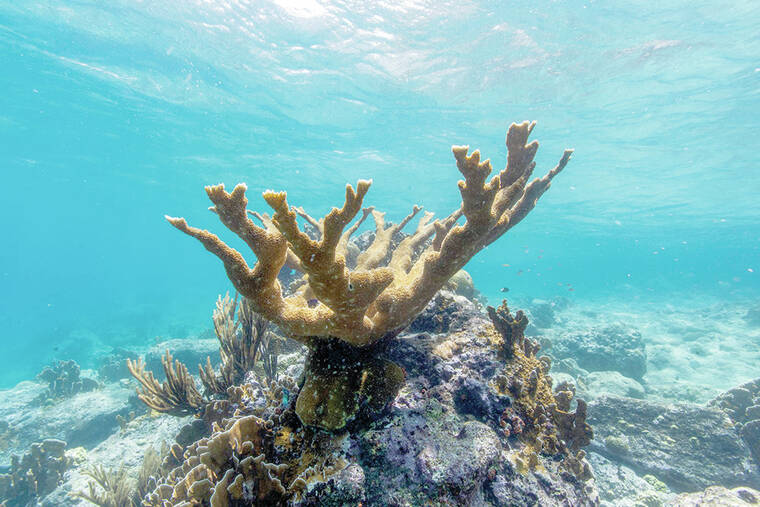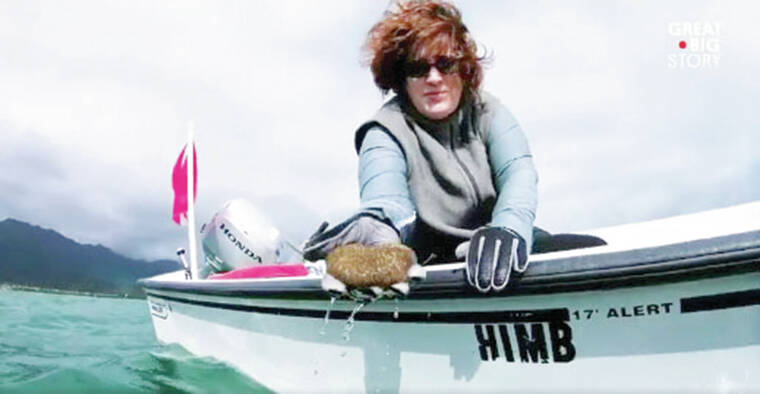LIHU‘E — In a first for conservation science, a team of marine biologists has successfully frozen and revived coral fragments — a seismic breakthrough for the fight to save Earth’s reefs from climate change-inflicted devastation.
“It will have an incredible impact, finger crossed,” said Mary Hagedorn, a research biologist at both the University of Hawai‘i at Manoa’s Hawai‘i Institute of Marine Biology (HIMB) and Smithonian’s National Zoo and Conservation Biology Institute, and co-author of a paper on cryopreservation of corals recently published in Nature Communications.
Climate change and the release of fossil fuels into the atmosphere have both increased the temperature and acidification of Earth’s oceans, as the waters soak up both heat and carbon dioxide. Both of these factors have resulted in significant coral bleaching across the globe, killing off reefs and making it more difficult for corals to reproduce.
This trend is only anticipated to grow — some models suggest 95 percent or more of the planet’s corals could die by the mid-2030s.
“Whether that model is correct or not, I think it’s a huge wake-up call,” Hagedorn said. “I think it’s alarming and it’s horrible.”
To protect corals from becoming endangered or extinct, biologists and conservationists have successfully cryopreserved (preserved samples using cold temperatures) over 50 coral species’ sperm and larvae since 2008.
However, this technique has several limitations.
For one, most of the planet’s corals are in remote locations, making it difficult to get teams out for sample collection.
Additionally, the window in which most corals’ sperm and larvae can be harvested each year is often only a few hours.
Finally, even if coral sperm is properly collected, it has to be frozen almost immediately after harvest, or else it becomes unviable.
“You can imagine that if you had two nights a year to develop a process, and the sperm is only good for, like, four hours, you have a total of about eight to 12 hours a year to get something to work,” Hagedorn said. “It’s very challenging.”
Furthermore, marine conservationists have hit a paradoxical challenge — as the oceans grow increasingly warmer and more acidic, these stressors decrease corals’ fertility levels, meaning fewer specimens collected for cryopreservation are ultimately successful in later repopulation efforts.
“We are up against a wall right now, in terms of reproduction,” Hagedorn said.
To get around the shortcomings of freezing coral sperm and larvae, Hagedorn’s team successfully found a way to cryopreserve entire living coral fragments through a process known as isochoric vitrification.
In this process, corals are cut into thin, wafer-like pieces ranging from the size of a thumbnail to a thumb’s length, Hagedorn said. After the corals heal from the cutting, they’re placed in small aluminum chambers filled with a viscous antifreeze solution. These chambers are then sealed and placed in liquid nitrogen, where the coral polyps rapidly freeze into a glass-like state.
Critically, the process ensures that no ice crystals form, protecting the polyps’ water-filled cells from bursting. The polyps can be kept in this state for long periods of time, and can be thawed on demand when the ocean’s conditions improve.
“As long as the material is kept in liquid nitrogen and well-tended, it can stay for tens of years for sure — and, theoretically, for thousands of years,” Hagedorn said.
Having proven that this concept works, the team’s next steps include perfecting both cryopreservation and post-thawing care techniques, after which they hope to collect as many unique samples as possible before time runs out for coral species.
“How do we get out of this? It takes time, it takes effort, it takes changing political will, etc.,” she said. “And that doesn’t happen overnight, oftentimes. But in the meantime, all these organisms are dying and are threatened. And so how do we stop that time for them? The way to do it is to cryopreserve them and give them an opportunity.”
“We won’t have coral reefs, right? It’s like saying that you have a whole forest in your tank — you don’t. You have the seeds of the beginning, but that’s better than nothing.”
•••
Jackson Healy, reporter, can be reached at 808-647-4966 or jhealy@thegardenisland.com.
Editor’s note: This story has been updated to reflect Mary Hagedorn’s association with the Smithonian’s National Zoo and Conservation Biology Institute.






